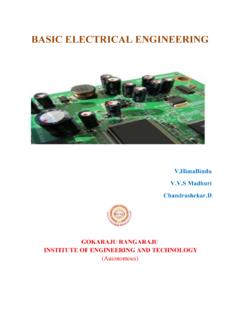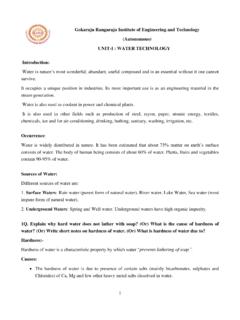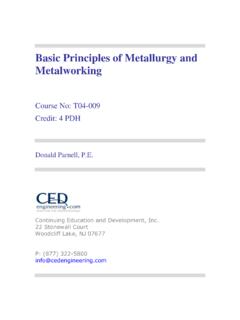Transcription of Engineering Physics I B.Tech CSE/EEE/IT & ECE
1 Engineering Physics I CSE/EEE/IT & ECE GRIET 1 ( CSE/EEE/IT & ECE) Engineering Physics Syllabus UNIT-I 1. Crystal Structures: Lattice points, Space lattice, Basis, Bravais lattice, unit cell and lattice parameters, Seven Crystal Systems with 14 Bravais lattices , Atomic Radius, Co-ordination Number and Packing Factor of SC, BCC, FCC, Miller Indices, Inter planer spacing of Cubic crystal system. 2. Defects in Crystals: Classification of defects, Point Defects: Vacancies, Substitution, Interstitial, Concentration of Vacancies, Frenkel and Schottky Defects, Edge and Screw Dislocations (Qualitative treatment), Burger s Vector.
2 3. principles of quantum mechanics : Waves and Particles, de Broglie Hypothesis, Matter Waves, Davisson and Germer s Experiment, Heisenberg s Uncertainty Principle, Schrodinger s Time Independent Wave Equation-Physical Significance of the wave Function-Particle in One Dimensional Potential Box. UNIT II 1. Electron Theory of Metals: Classical free electron theory, Derivation of Ohm s law, Mean free path, Relaxation time and Drift velocity, Failures of Classical free electron theory, quantum free electron theory, Fermi-Dirac distribution, Fermi energy, Failures of quantum free electron theory. 2. Band Theory of Solids: Electron in a periodic potential, Bloch Theorem, Kronig-Penny Model(Qualitative Treatment), origin of Energy Band Formation in Solids, Classification of Materials into Conductors, Semi Conductors & Insulators, Effective mass of an Electron.
3 3. Semiconductor Physics : Intrinsic Semiconductors and Carrier Concentration, Extrinsic Semiconductors and Carrier Concentration, Fermi Level in Intrinsic and Extrinsic Semiconductors, Hall Effect and Applications. UNIT III 1. Dielectric Properties: Electric Dipole, Dipole Moment, Dielectric Constant, Polarizability, Electric Susceptibility, Displacement Vector, Types of polarization: Electronic, Ionic and Orientation Polarizations and Calculation of Polarizabilities (Electronic & Ionic) -Internal Fields in Solids, Clausius -Mossotti Equation, Piezo-electricity and Ferro- electricity. 2. Magnetic Properties: Magnetic Permeability, Magnetic Field Intensity, Magnetic Field Induction, Intensity of Magnetization, Magnetic Susceptibility, Origin of Magnetic Moment, Bohr Magnetron, Classification of Dia, Para and Ferro Magnetic Materials on the basis of Magnetic Moment, Hysteresis Curve on the basis of Domain Theory of Ferro Magnetism, Soft and Hard Magnetic Materials, Ferrites and their Applications.
4 UNIT IV 1. Lasers: Characteristics of Lasers, Spontaneous and Stimulated Emission of Radiation, Meta-stable State, Population Inversion, Einstein s Coefficients and Relation between them, Ruby Laser, Helium-Neon Laser, Semiconductor Diode Laser, Applications of Lasers. 2. Fiber Optics: Structure and Principle of Optical Fiber, Acceptance Angle, Numerical Aperture, Types of Optical Fibers (SMSI, MMSI, MMGI), Attenuation in Optical Fibers, Application of Optical Fibers, Optical fiber Communication Link with block diagram. UNIT V 1. Nanotechnology: Origin of Nanotechnology, Nano Scale, Surface to Volume Ratio, Bottom-up Fabrication: Sol-gel Process; Top-down Fabrication: Chemical Vapor Deposition, Physical, Chemical and Optical properties of Nano materials, Characterization (SEM, EDAX), Applications.
5 Engineering Physics I CSE/EEE/IT & ECE GRIET 2 Unit -1:Crystal Structures,Crystal Defects & principles of quantum mechanics Part-A (SAQ-2 Marks) 1) Define a) Space Lattice b) Basis c) Co-ordination number d) Packing factor e) Miller Indices. a) Space lattice: is defined as an infinite array of points in three dimensions in which every point has surroundings identical to that of every other point in the array. b) Basis: Group of atoms or molecules identical in composition. Lattice + basis = crystal structure c) Co-ordination number: The no of equidistant neighbors that an atom has in the given structure.
6 Greater the co-ordination no, the atoms are said to be closely packed. For Simple Cubic: 6, BCC: 8, FCC: 12 d) Packing factor (PF): It is the ratio of volume occupied by the atoms or molecule in unit cell to the total volume of the unit cell. Atomic Packing Factor (APF) = Volume of all the atoms in Unit cell For Simple Cubic: 52%, BCC: 68%, FCC: 74% e) Miller Indices: are the reciprocals of intercepts made by the planes on the crystallographic axis when reduced to smallest integers. 2) Describe seven crystal systems with lattice parameters and Bravais Lattice points. S:No Name of the crystal systems Primitives Interfacial angles Bravais Lattice points 1 2 3 4 5 6 7 Cubic Tetragonal Orthorhombic Monoclinic Triclinic Trigonal Hexagonal a= b= c a= b c a b c a b c a b c a= b= c a= b c = = =90o = = =90o = = =90o = =90o 90o = = 90o = =90oand =120o 3(P,I,F) 2(P,I) 4(P,C,I,F) 2(P,C) 1(P) 1(P) 1(P) 3) Define a) Crystal Structure b) Lattice Parameters c) Unit Cell d) Atomic radius (r).
7 A) Crystal structure: periodic arrangement of atoms or molecules in 3D space. b) Lattice parameters: the primitives (a,b,c) and interfacial angles ( , , ,) are the basic lattice parameters which determine the actual size of unit cell. c) Unit cell: is a minimum volume cell which on repetition gives actual crystal structure. Engineering Physics I CSE/EEE/IT & ECE GRIET 3 d) Atomic radius (r) The atomic radius is defined as half the distance between neighboring atoms in a crystal of pure element. 4) What are properties of matter Waves. De-Broglie proposed the concept of matter waves, according to which a material particle of mass m , moving with a velocity V should have an associated wavelength called de-Broglie wavelength.
8 =hmv=hp Wavelength is associated with moving particle and independent of charge of the particles. Greater the mass, velocity of the particle, lesser will be the wavelength. Part- B (Descriptive- 10marks) 1) Calculate the Packing factor of SC, BCC, FCC (or) Show that FCC is the closest packing of all the three cubic structures. Simple cubic: There are 8 atoms at 8 corners of the cube. The corner atoms touch with each other. If we take a corner atom as a reference, this atom is surrounded by 6 equidistant nearest neighbors. Co-ordination number: - (N) = 6:- is defined as number of equidistant nearest neighbors that an atom has in the given structure.
9 Total number of atoms :- (n) =1:- each corner atom is shared by 8 unit cells, the share of each corner atom to a unit cell is 1/8 th of an atom (8 1/8 =1) Nearest neighbor distance (2r):- the distance between centers of two nearest neighbor atoms will be 2r if r is the radius of the atom. Atomic radius: - (r) = 2r:- is defined as the distance between nearest neighbors in a crystal. Lattice constant: - a =2r Atomic Packing Factor (APF) = Volume of all the atoms in Unit cell 1 43 3 3=(2 )3= % Ex:-polonium at room temperature. Body centered Cubic (BCC): In a unit cell there are 8 atoms at 8 corners and another 1 atom at the body center.
10 The 8 corner atoms are shared by 8 unit cells, and as the center atom is entirely within the unit cell, it is not shared by any surrounding unit cell. Engineering Physics I CSE/EEE/IT & ECE GRIET 4 Co-ordination number =8 Nearest neighbor distance = 32 Lattice constant = a= 4 3 Number of atoms per unit cell = v= 1 Volume of all atoms in unit cell = v = 2 4/3 r3 Volume of unit cell =V= a3=(4 3)3 Atomic Packing Factor is 2 43 3(4 3)3 = = 68% Ex: - Li, Na, K, and Cr. Face centered structure (FCC) In FCC there are 8 atoms at 8 corners of the unit cell and 6 atoms at 6 faces.







